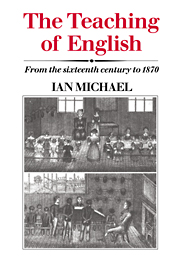Book contents
- Frontmatter
- Contents
- List of tables
- Preface
- 1 The enquiry: scope, method, texts
- 2 Reading, spelling, pronunciation: the elements
- 3 Reading, spelling, pronunciation: the skills
- 4 Interpretation: literature presented
- 5 Interpretation: literature taught
- 6 Expression and performance
- 7 Linguistic control
- 8 English: the development of a subject
- Abbreviations
- Bibliography 1
- Bibliography 2
- Bibliography 3
- Bibliography 4
- Index
4 - Interpretation: literature presented
Published online by Cambridge University Press: 05 June 2012
- Frontmatter
- Contents
- List of tables
- Preface
- 1 The enquiry: scope, method, texts
- 2 Reading, spelling, pronunciation: the elements
- 3 Reading, spelling, pronunciation: the skills
- 4 Interpretation: literature presented
- 5 Interpretation: literature taught
- 6 Expression and performance
- 7 Linguistic control
- 8 English: the development of a subject
- Abbreviations
- Bibliography 1
- Bibliography 2
- Bibliography 3
- Bibliography 4
- Index
Summary
The teaching of literature: before 1700
Indirect literary influences
This discussion of the teaching of reading has been restricted so far to what is often called the mechanism of reading; we have not been concerned with the substance of what was read. The term ‘mechanism’ is dangerous. It implies that a person learning to read is not concerned with, nor influenced by, the meaning of what he reads, that the process is mechanical in the sense that the reader transfers, by rule or by imitation, a set of visual symbols into a spoken or mental equivalent, to which meaning is attached only by a separate process. But such a view is implied by the practice of most teachers until well into the nineteenth century. The term is historically appropriate. At all times, of course, teachers have wanted their pupils to understand what they read, but that intention is not the same as the relatively modern view that understanding what you are trying to read helps you to recognise and to form the words themselves. The nearest equivalent in earlier times to the latter view was the occasional use made of context and setting that is discussed in chapter 3. The present question is not, primarily, what did children read, but what were they taught to read when mechanical reading had been achieved? What was offered to them with pedagogical intent? What were the intentions with which it was offered, and by what methods were they realised?
- Type
- Chapter
- Information
- The Teaching of EnglishFrom the Sixteenth Century to 1870, pp. 135 - 182Publisher: Cambridge University PressPrint publication year: 1987

